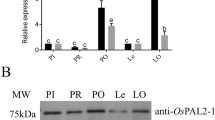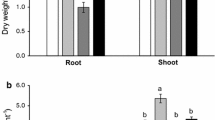Abstract
Aims
Phytophthora root rot (PRR) of soybean is a destructive soil-borne disease caused by Phytophthora sojae (Ps). Isoflavonoids daidzein and genistein in soybean root exudates mediate soybean susceptibility. However, no attention has been paid to the inhibitors in the resistant soybean root exudates. This study aims to identify the metabolites which participate in host susceptibility and resistance in soybean root exudates.
Methods
The metabolomes of rhizosphere soil of a pair soybean near-isogenic lines Williams (rps, susceptible) and Williams 82 (Rps1k, resistant) were analyzed by LC–MS. The effects of rhizosphere soil on Ps were determined. The expression levels of core metabolites synthetase related genes were quantified by qRT-PCR.
Results
Clear differences were found in the rhizosphere metabolites between susceptible Williams and resistance Williams 82. Higher accumulations of daidzein and genistein were observed in susceptible Williams. Other abundant flavones and isoflavonoids closely related to daidzein and genistein likely participate in the susceptibility of Williams to Ps. Antibiotics mannan, cis-β-D-glucosyl-2-hydroxycinnamate, vanillic acid and 2-(4-hydroxyphenyl) ethanol are likely related to pre-existing resistance of Williams 82 to Ps. The rhizosphere metabolites altered greatly under Ps inoculation. Weak and strong induced resistance to Ps were observed in Williams and Williams 82. Less flavones and isoflavonoids, and abundant 13-L-hydroperoxylinoleic acid are likely related to the weak induced resistance of Williams to Ps. While 9,10,13-TriHOME, 9,12,13-TriHOME, N2-acetyl-L-ornithine, paromomycin and 2- (4-hydroxyphenyl) ethanol are likely related to the induced resistance of Williams 82 to Ps. Additionally, there were other abundant metabolites in Williams and Williams 82 rhizosphere. Functions of these metabolites in pre-existing and induced resistance to Ps need to be further studied.
Conclusions
Different core metabolites in the rhizosphere soil participate in the susceptibility and resistance of host soybean to Ps.








Similar content being viewed by others
References
Balaraju K, Kim CJ, Park DJ, Nam KW, Zhang K, Sang MK, Park K (2016) Paromomycin derived from Streptomyces sp AG-P 1441 induces resistance against two major pathogens of chili pepper. J Microbiol Biotechnol 26:1542–1550
Berg G, Smalla K (2009) Plant species and soil type cooperatively shape the structure and function of microbial communities in the rhizosphere. FEMS Microbiol Ecol 68:1–13
Bernard RL, Cremeens CR (1988) Registration of “Williams 82” soybean. Crop Sci 28:1027–1028
Bernard RL, Lindahl DA (1972) Registration of Williams Soybean. Crop Sci 5:716–716
Bi X, Song G, Yu H, Zhang Z, Liu H, Yang Z, Chen Y, Wen J (2022) Changes in biochemistry and cellular ultrastructure support different resistance mechanisms to Phytophthora sojae in nonhost common bean and host soybean. Plant Pathol 00:1–10. https://doi.org/10.1111/ppa.13527
Chen G, Komatsuda T, Ma J, Li C, Yamaji N, Nevo E (2011) A functional cutin matrix is required for plant protection against water loss. Plant Signal Behav 6:1297–1299
Chen Q, Li N, Done L, Zhang D, Fan S, Jiang L, Wang X, Xu P, Zhang S (2015) Overexpression of soybean isoflavone reductase (GmIFR) enhances resistance to Phytophthora sojae in soybean. Front Plant Sci 6:1024
Dhanyalakshmi KH, Soolanayakanahally RY, Rahman T, Tanino KK, Nataraja KN (2019) Leaf cuticular wax, a trait for multiple stress resistance in crop plants. IntechOpen, London
Donaldson SP, Deacon JW (1993) Effects of amino acids and sugars on zoospore taxis, encystment and cyst germination in Pythium aphanidermatum (Edson) Fitzp., P. catenulatum Matthews and P. dissotocum Drechs. New Phytol 123:289–295
Fu H, Liu F, Li S, Wang C, Zhang X, Wang Y, Zhu H, Wang K (2011) Screening of Verticillium wilt resistance on Gossypium hirsutum races and their root exudate effects on the wilt pathogen. Cotton Sci 5:387–393
Gu Y, Wei Z, Wang X, Friman V, Huang J, Wang X, Mei X, Xu Y, Shen Q, Jousset A (2016) Pathogen invasion indirectly changes the composition of soil microbiome via shifts in root exudation profile. Biol Fertil Soils 52:997–1005
Gu Y, Wang X, Yang T, Friman V, Geisen S, Wei Z, Xu Y, Jousset A, Shen Q (2020) Chemical structure predicts the effect of plant-derived low-molecular weight compounds on soil microbiome structure and pathogen suppression. Funct Ecol 34:2158–2169
Henry RJ, Furtado A, Vanambathina P, Rachaouti RCN, Furtado A (2022) Secondary genepool of Australian Cajanus species contains sources of resistance to Helicoverpa armigera (Hübner). Ann Appl Biol 180:259–272
Hosseini S, Heyman F, Olsson U, Broberg A, Jensen DF, Karlsson M (2014) Zoospore chemotaxis of closely related legume-root infecting Phytophthora species towards host isoflavones. Plant Pathol 63:708–714
Hua C, Yang X, Wang Y (2015) Phytophthora sojae and soybean isoflavones, a model to study zoospore chemotaxis. Physiol Mol Plant Pathol 92:161–165
Huang A, Jiang T, Liu Y, Bai Y, Reed J, Qu B, Gossens A, Nutzmann H, Bai Y, Osbourn A (2019) A specialized metabolic network selectively modulates Arabidopsis root microbiota. Science 364:546
Jiang G, Zhang Y, Gan G, Li W, Wan W, Jiang Y, Yang T, Zhang Y, Xu Y, Wang Y, Shen Q, Wei Z, Dini-Andreote F (2022) Exploring rhizo-microbiome transplants as a tool for protective plant-microbiome manipulation. ISME Commun 2. https://doi.org/10.1038/s43705-022-00094-8
Jones J, Dangl J (2006) The plant immune system. Nature 444:323–329
Li C, Liu X (2004) Study on relative physiological and biochemical characteristics of Chinese Cabbage resistance to Cercosporella albomaculance. Liaoning Agric Sci 3:8–10
Liu H, Yu H, Zhang Z, Bi X, Yang Z, Chen Y, Gu X, Wen J (2021) The adaptability of Phytophthora sojae to diferent types of soil determines the distribution of Phytophthora root rot of soybean in Heilongjiang Province of China. Eur J Plant Pathol. https://doi.org/10.1007/s10658-021-02387-5
Lozovaya VV, Lygin AV, Zernova OV, Li S, Hartman GL, Widholm JM (2004) Isoflavonoid accumulation in soybean hairy roots upon treatment with Fusarium solani. Plant Physiol Biochem 42:671–679
Lv J, Dong Y, Dong K, Zhao Q, Yang Z, Chen L (2020) Intercropping with wheat suppressed Fusarium wilt in faba bean and modulated the composition of root exudates. Plant Soil 448:153–164
Mohri S, Endo Y, Matsuda K, Kitamura K, Fujimoto K (1990) Physiological effects of soybean seed lipoxygenases on insects. J Agric Chem Soc Jpn 54:2265–2270
Moore LD, Stan JV, Gay TE, Rosier CL, Wu T (2016) Alteration of soil chitinolytic bacterial and ammonia oxidizing archaeal community diversity by rainwater redistribution in an epiphyte-laden Quercus virginiana canopy. Soil Biol Biochem 100:33–41
Naher UA, Radziah O, Halimi MS, Shamsuddin ZH, Modh RI (2009) Influence of root exudate carbon compounds of three rice genotypes on rhizosphere and endophytic diazotrophs. Pertanika J Trop Agric Sci 32:209–223
Nigarish M, Cheng C, Xia C, Xu X, Muhammad AN, Junaid I (2019) RNA-Seq analysis reveals an essential role of tyrosine metabolism pathway in response to root-rot infection in Gerbera hybrida. PLoS ONE 14:e0223519
Ning L, Zhang W, Wang D, Mao J, Huang Q, Guo S, Shen Q (2013) Root exudates from grafted-root watermelon showed a certain contribution in Inhibiting Fusarium oxysporum f. sp. niveum. PloS One 8:e63383
Richard A (2001) Natural products and plant disease resistance. Nature 6839:843–847
Silvar C, Merino F, Díaz J (2008) Differential activation of defense-related genes in susceptible and resistant pepper cultivars infected with Phytophthora capsici. J Plant Physiol 165:1120–1124
Sindhu S, Rakshiya Y, Sahu G (2009) Biological control of soilborne plant pathogens with rhizosphere bacteria. Res India Publ 3:10–21
Slininger PJ, Burkhead KD, Schisler DA (2004) Antifungal and sprout regulatory bioactivities of phenylacetic acid, indole-3-acetic acid, and tyrosol isolated from the potato dry rot suppressive bacterium Enterobacter cloacae S11:T:07. J Ind Micbiol Biotechnol 31:517–524
Thomas R, Fang X, Ranathunge K, Anderson TR, Peterson CA, Bernards M (2007) Soybean root suberin: anatomical distribution, chemical composition, and relationship to partial resistance to Phytophthora sojae. Plant Physiol 144:299–311
Tofazzal IM, Yasuyuki H, Toshiaki I, Satoshi T (2004) Interruption of the homing events of Phytopathogenic Aphanomyces cochlioides zoospores by secondary metabolites from nonhost Amaranthus gangeticus. J Pestic Sci 29:6–14
Tyler BM (2002) Molecular basis of recognition between Phytophthora pathogens and their hosts. Annu Rev Phytopathol 40:137–167
Tyler BM (2007) Phytophthora sojae: root rot pathogen of soybean and model oomycete. Mol Plant Pathol 8:1–8
Wang Y (2018) Phytophthora sojae effectors orchestrate warfare with host immunity. Curr Opin Microbiol 46:7–13
Wang W, Jiao F (2019) Effectors of Phytophthora pathogens are powerful weapons for manipulating host immunity. Planta 250:413–425
Wen T, Zhao M, Liu T, Huang Q, Yuan J, Shen Q (2020) High abundance of Ralstonia solanacearum changed tomato rhizosphere microbiome and metabolome. BMC Plant Biol 20:166
Wen J, Yu H, Zhang Z, Bi X, Liu H, Yang Z, Song G, Zhang X, Tang Y, Chen Y (2021) Effect of phenolic acids in seed exudates on growth and development and zoospores chemotaxis of Phytophthora sojae. J Northeast Agric Univ 314:11–19
Wu F, Xue H, Xue Z (2006) Allelopathic effect of root exudates of cucumber cultivars on Fusarium oxysporum. Allelopathy J 18:163–172
Yang S, Wang G, Yang H, Luo J, Cheng L (2015) Comparison of amino acids in root exudates of flue-cured tobacco varieties with different resistances against Black Shank. Plant Dis Pests 6:12–16
Yang J, Zheng S, Wang X, Ye W, Zheng X, Wang Y (2020) Identification of resistance genes to Phytophthora sojae in domestic soybean cultivars from China using particle bombardment. Plant Dis 104. https://doi.org/10.1094/PDIS-10-19-2201-RE
Zeng W, Sun Z, Cai Z, Chen H, Lai Z, Yang S, Tang X (2017) Proteomic analysis by iTRAQ-MRM of soybean resistance to Lamprosema Indicate. BMC Genomics 18:444
Zhang J, Wang J, Xu Y (2008) Effect of amino acids from soybean root exudates on hyphal growth of pathogenic fungi of soybean root rot. J Plant Nutr Fertilize Sci 14:308–315
Zhang Z, Xu Y, Song G (2019) Phytophthora sojae zoospores differ in chemotaxis to the root and root exudates of host soybean and nonhost common bean. J Gen Plant Pathol 85:201–210
Zhang Z, Liu H, Bi X (2020) Differential response of Phytophthora sojae zoospores to soybean seed exudates provides evidence of seed exudates participate in host resistance. Plant Soil 452:601–614
Acknowledgements
Thanks for the technological support of Sangon (Shanghai, China). This research was supported by the National Natural Science Foundation of China [grant number 32071637] to Jingzhi Wen and by Laboratory of Plant Pathology, Northeast Agricultural University.
Author information
Authors and Affiliations
Corresponding author
Ethics declarations
Declaration of interests
The authors declare that they have no known competing financial interests or personal relationships that could have appeared to influence the work reported in this paper.
Additional information
Responsible Editor: Birgit Mitter.
Publisher's Note
Springer Nature remains neutral with regard to jurisdictional claims in published maps and institutional affiliations.
Supplementary Information
Below is the link to the electronic supplementary material.
Rights and permissions
About this article
Cite this article
Zhang, Z., Bi, X., Du, X. et al. Comparative metabolomics reveal the participation of soybean unique rhizosphere metabolites in susceptibility and resistance of host soybean to Phytophthora sojae. Plant Soil 480, 185–199 (2022). https://doi.org/10.1007/s11104-022-05571-6
Received:
Accepted:
Published:
Issue Date:
DOI: https://doi.org/10.1007/s11104-022-05571-6




